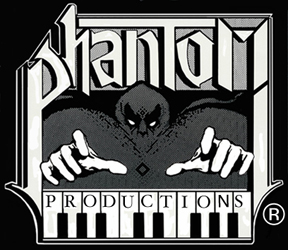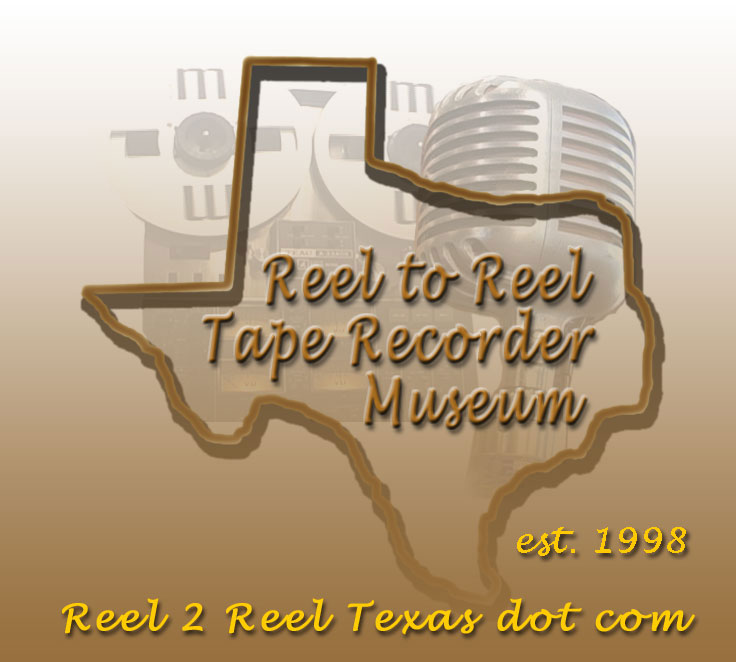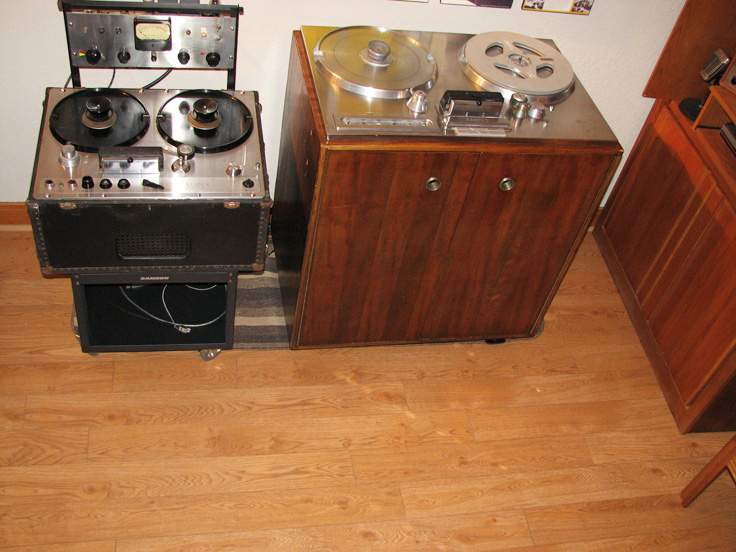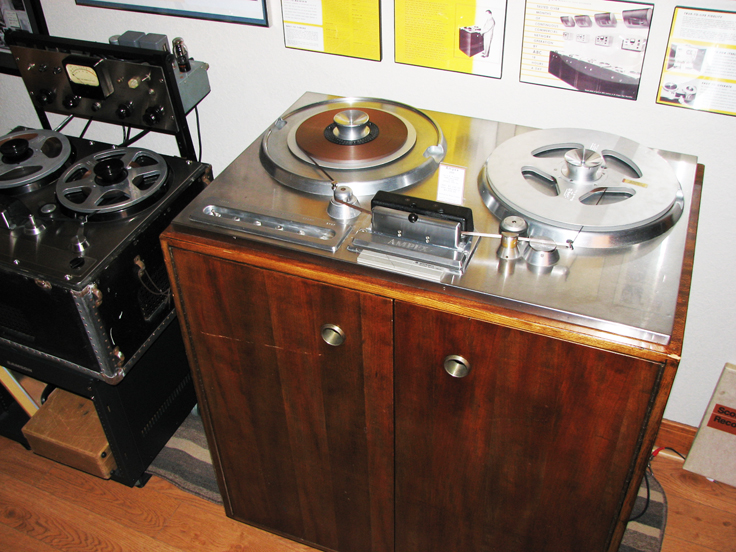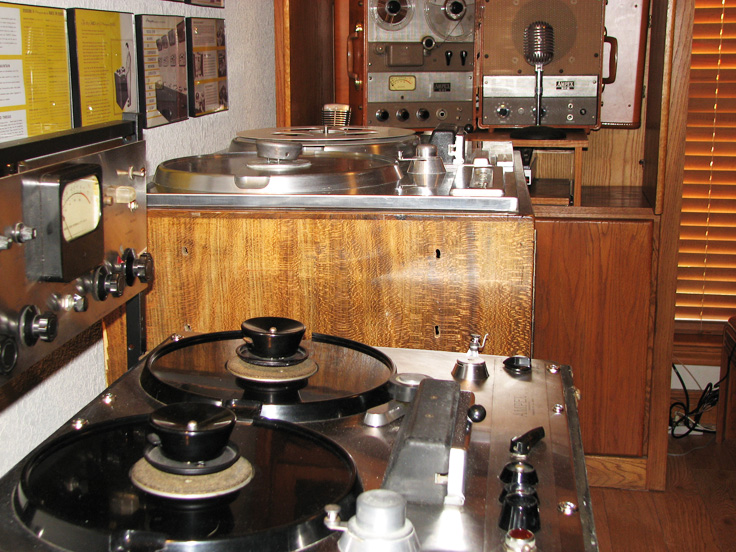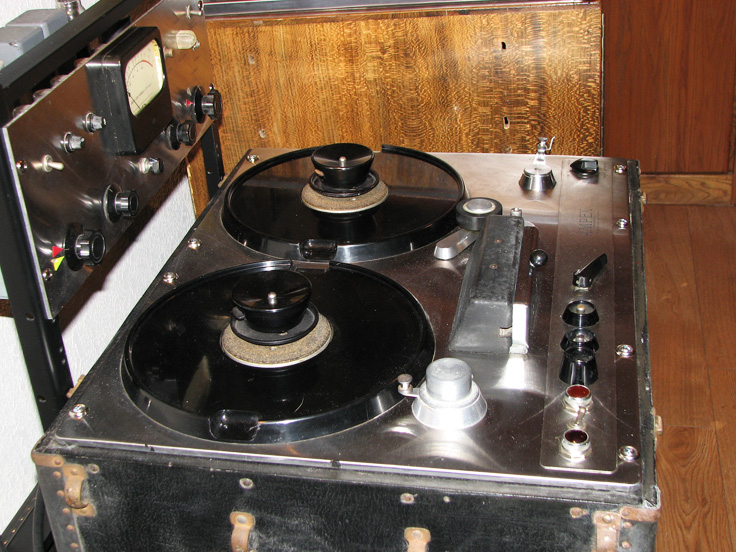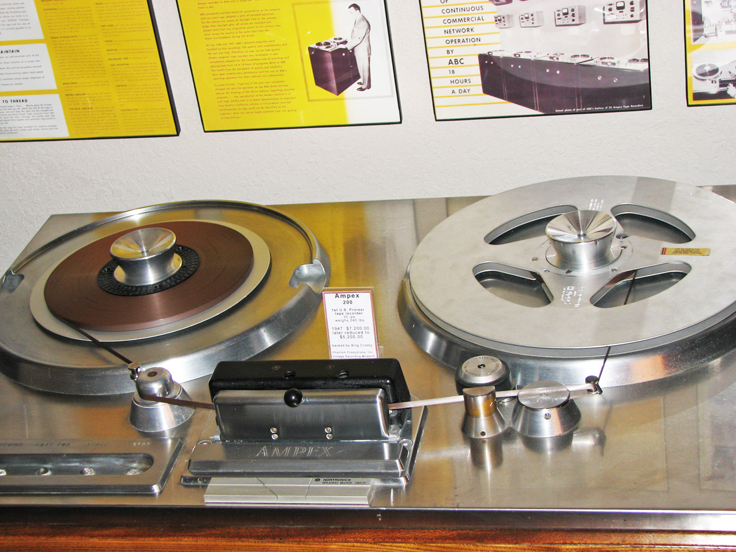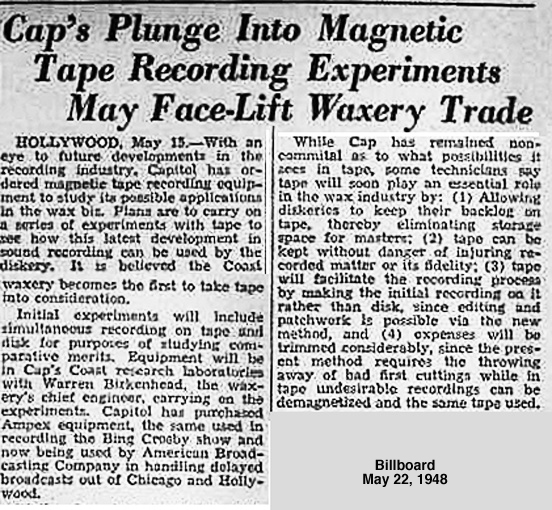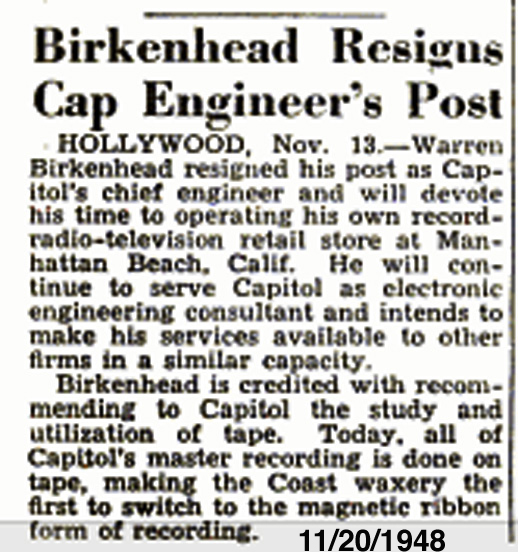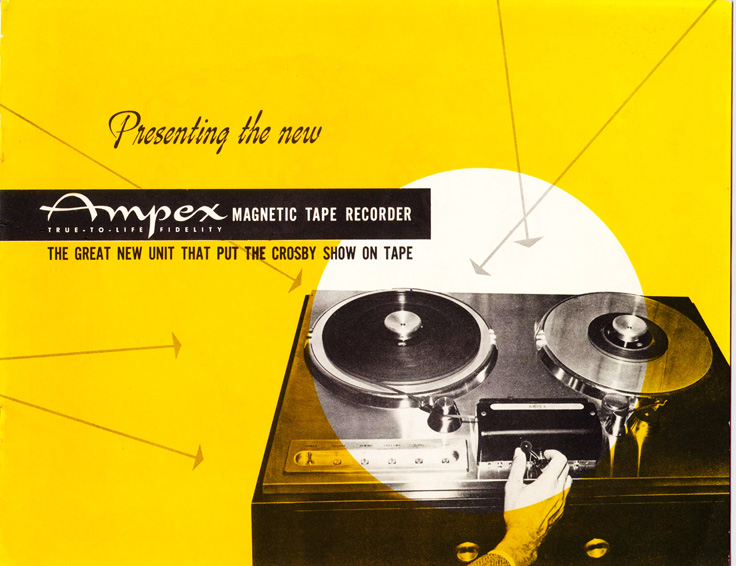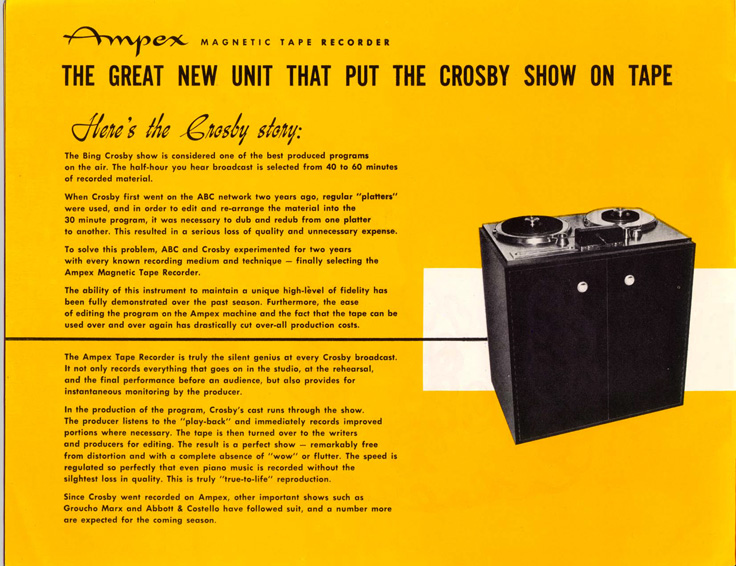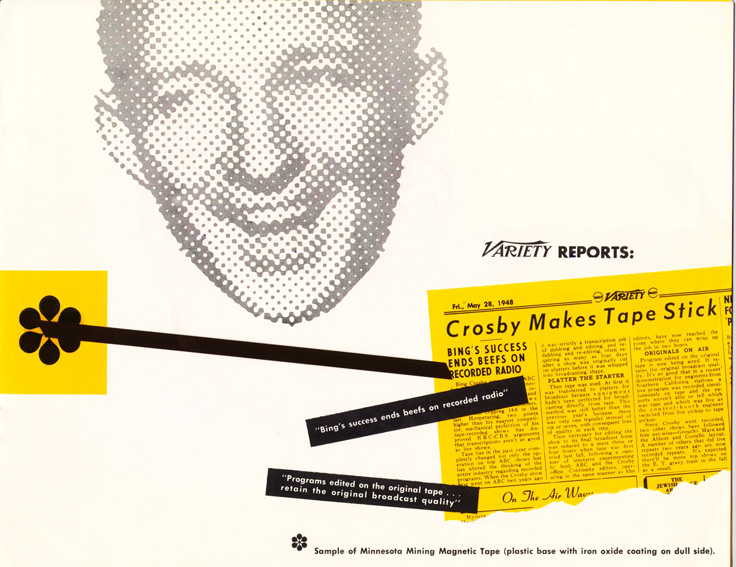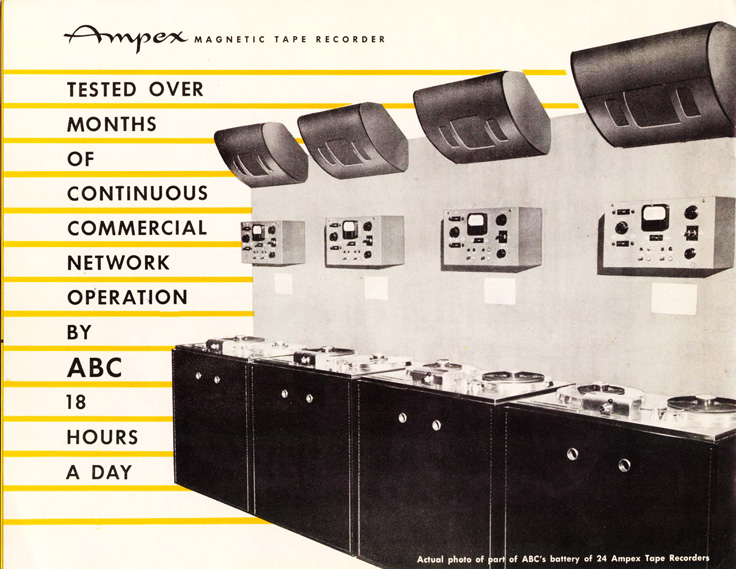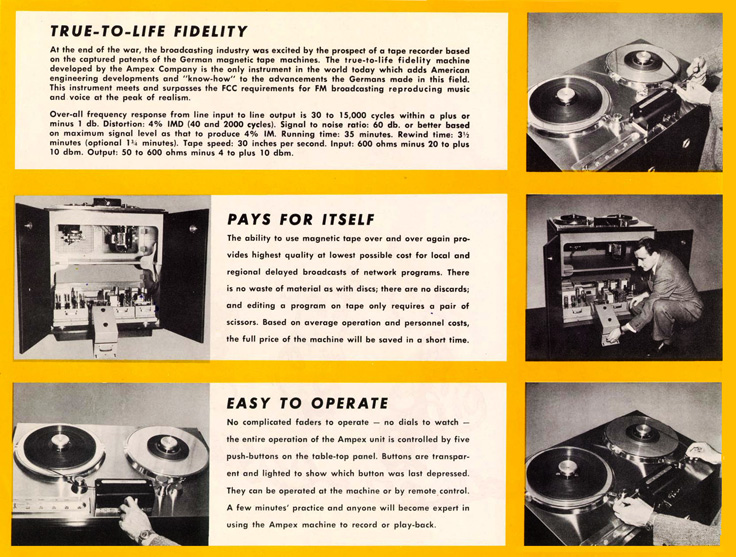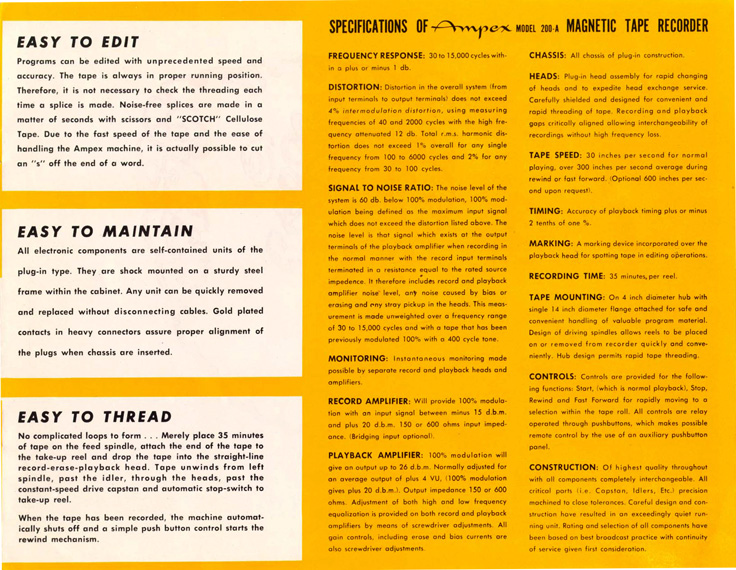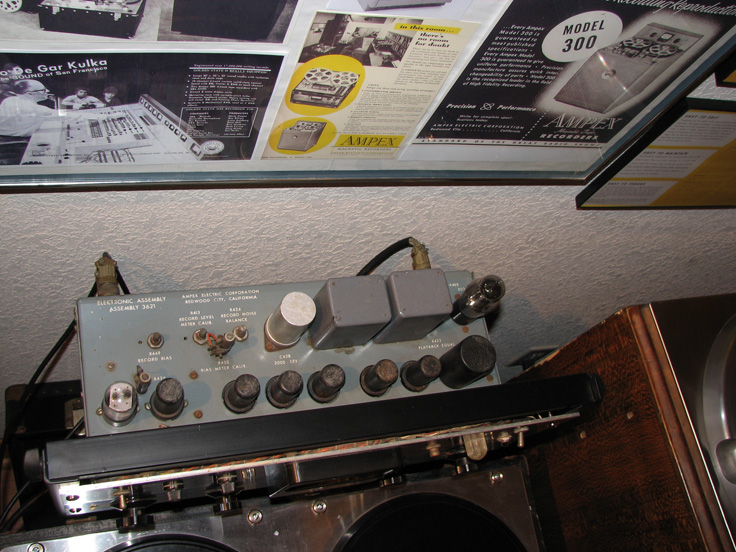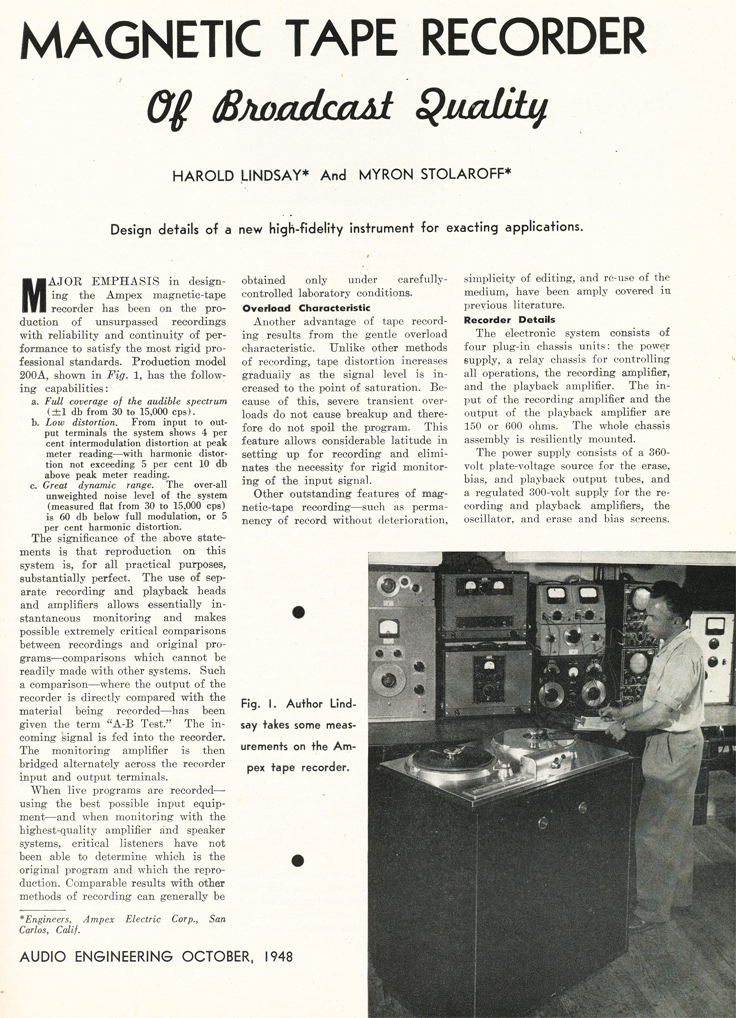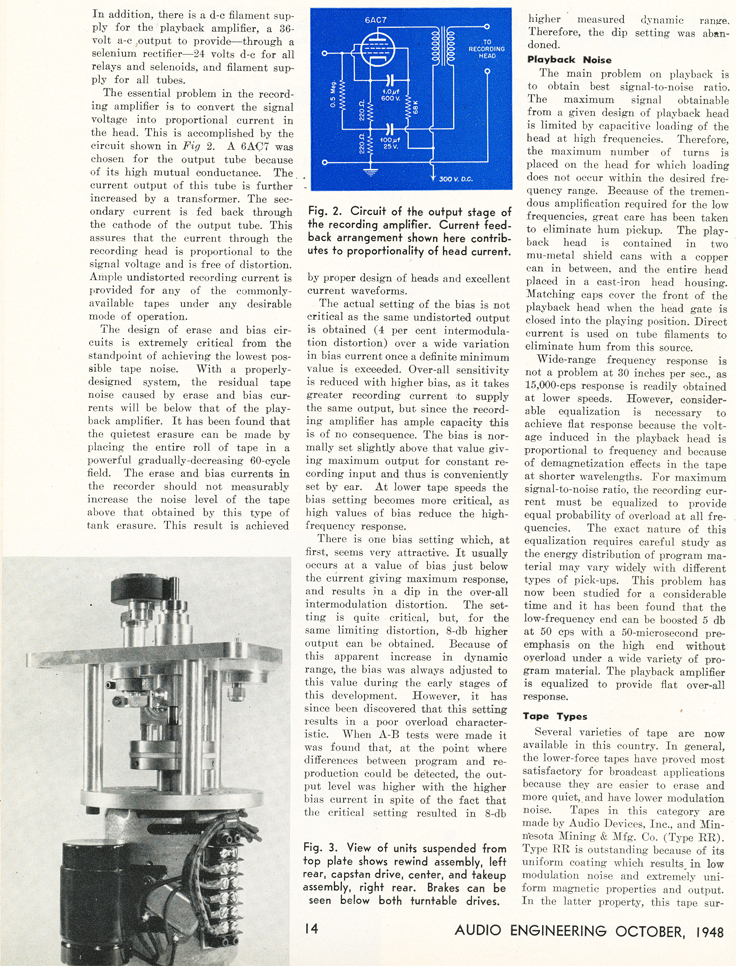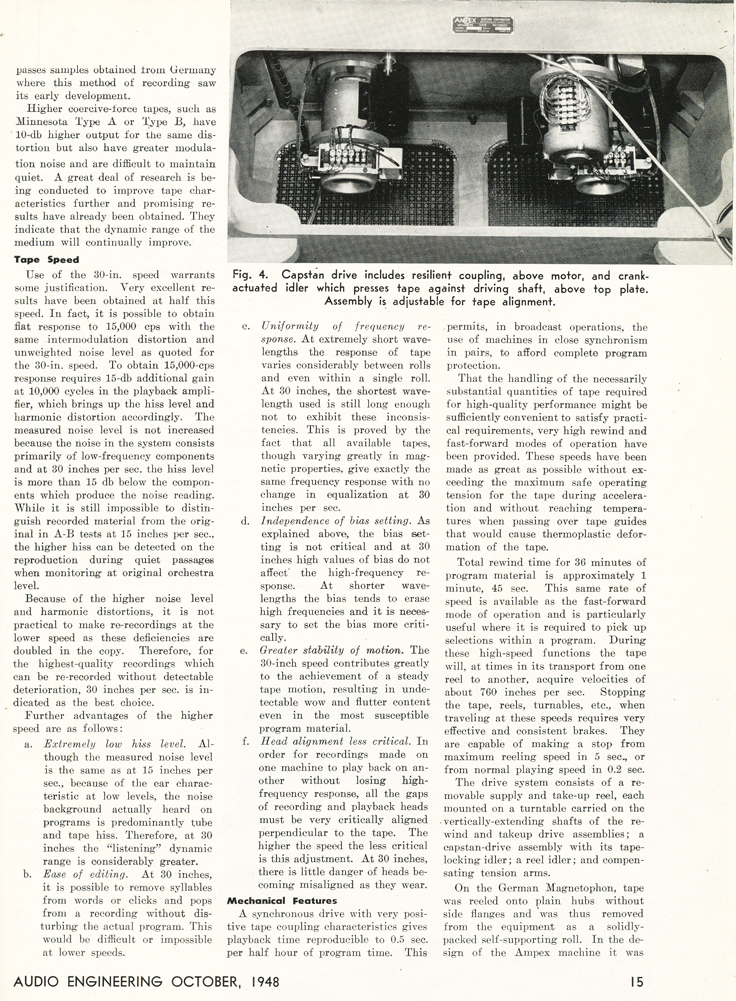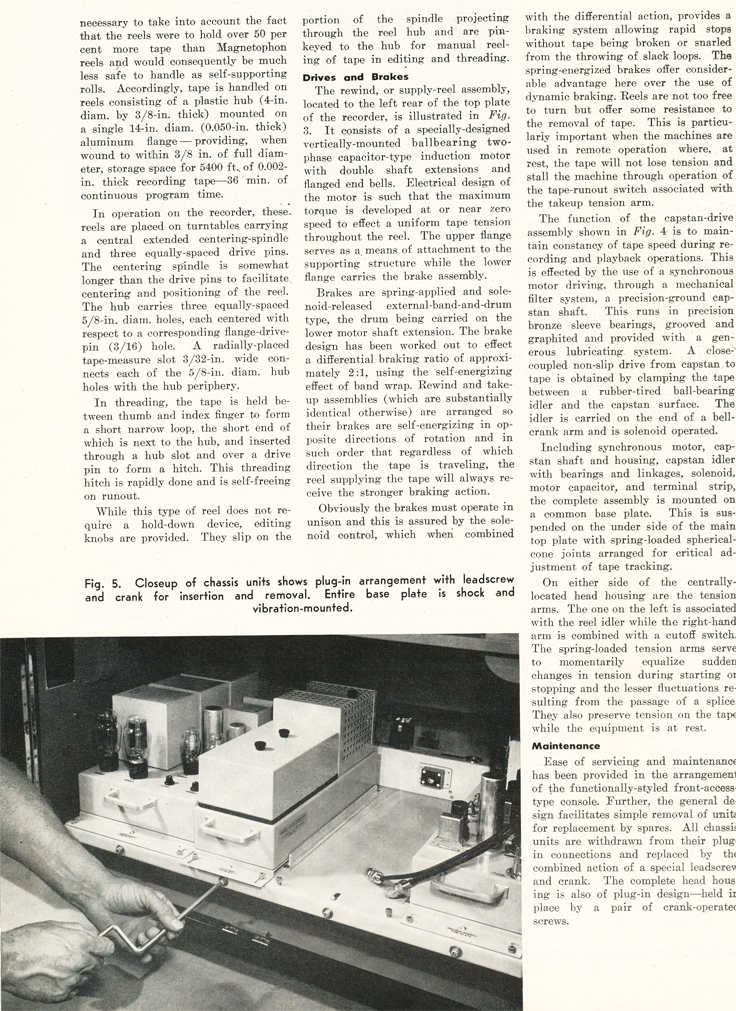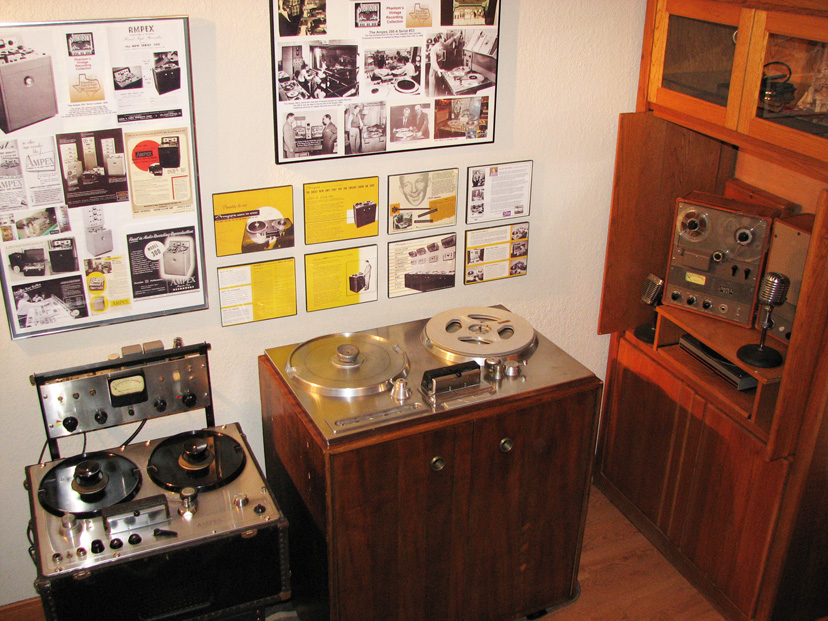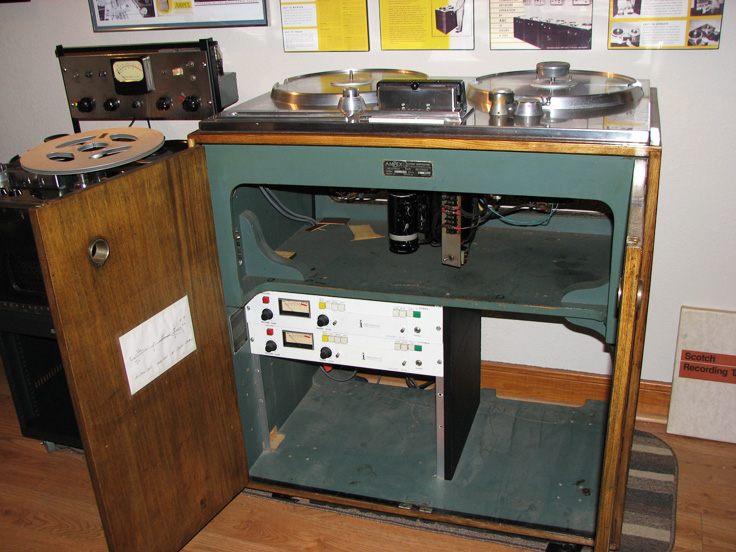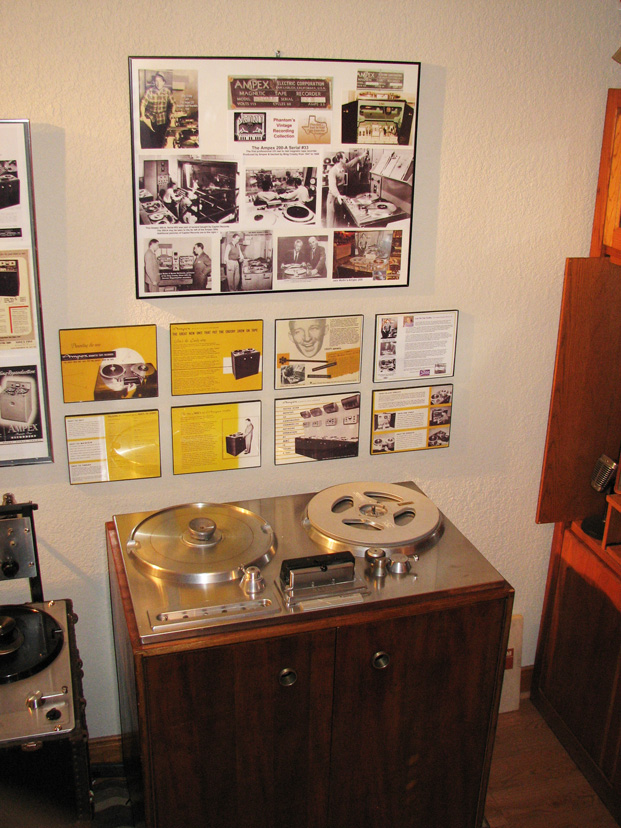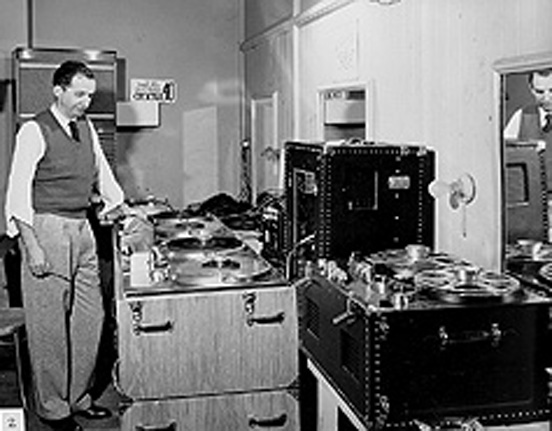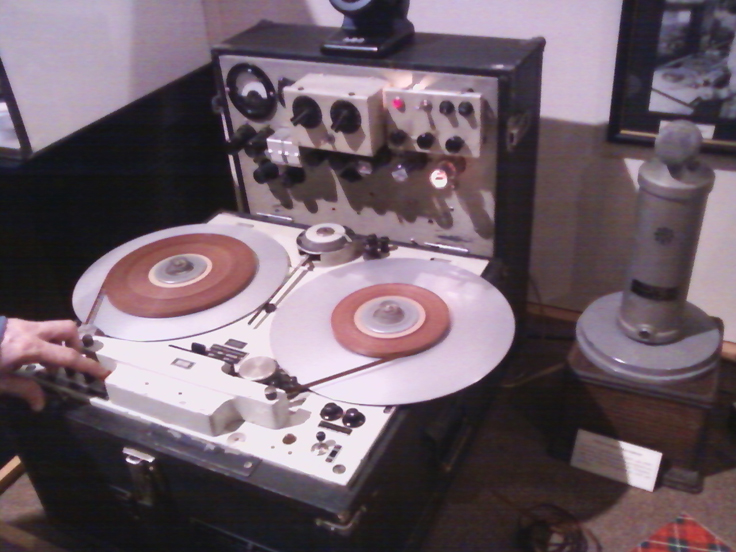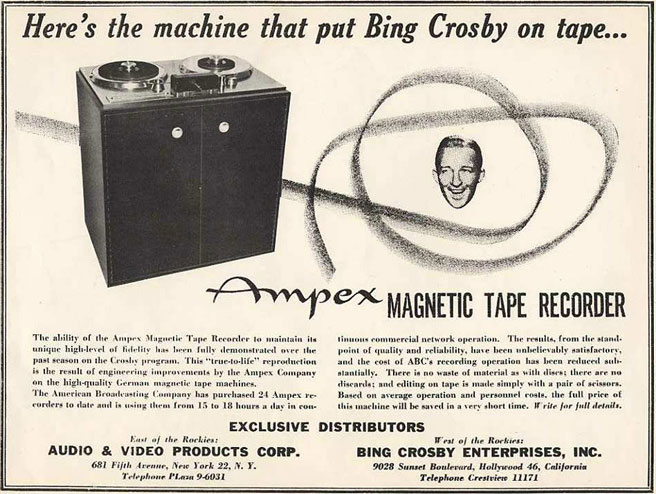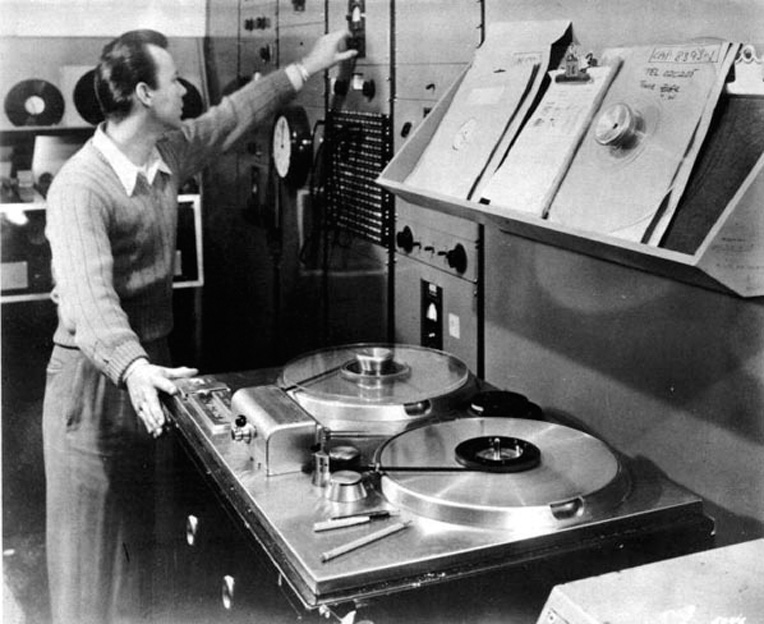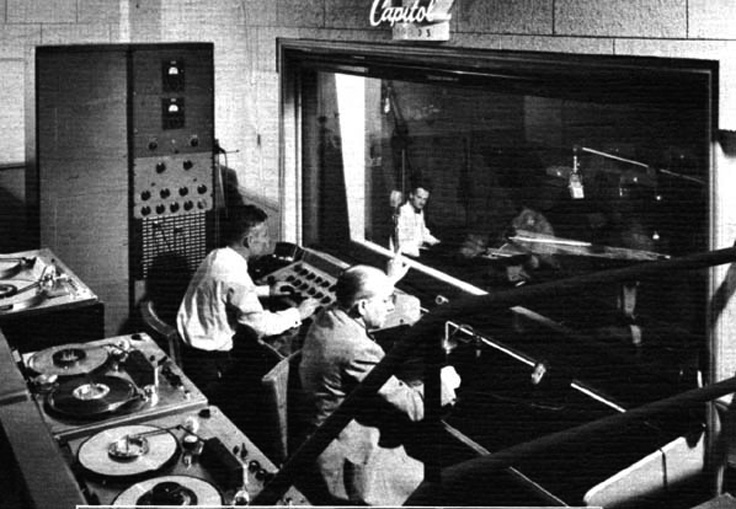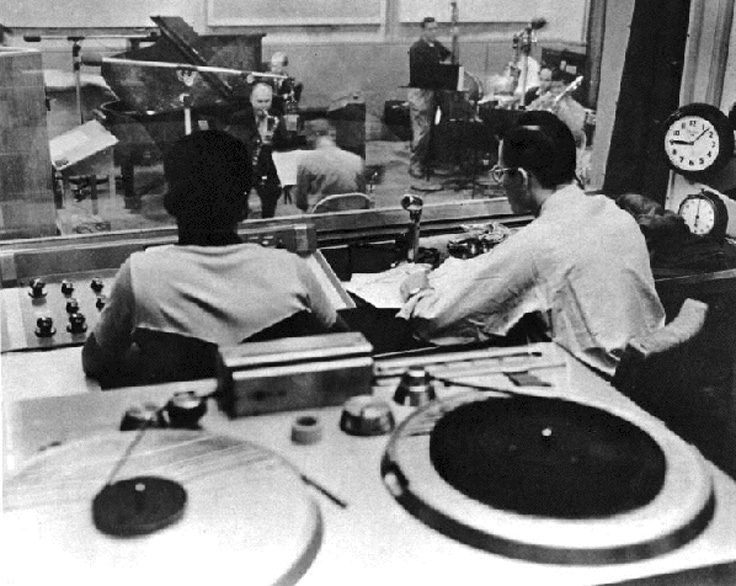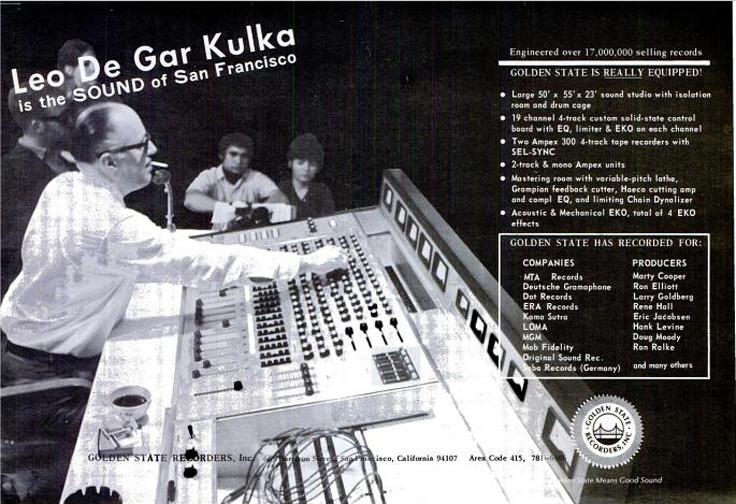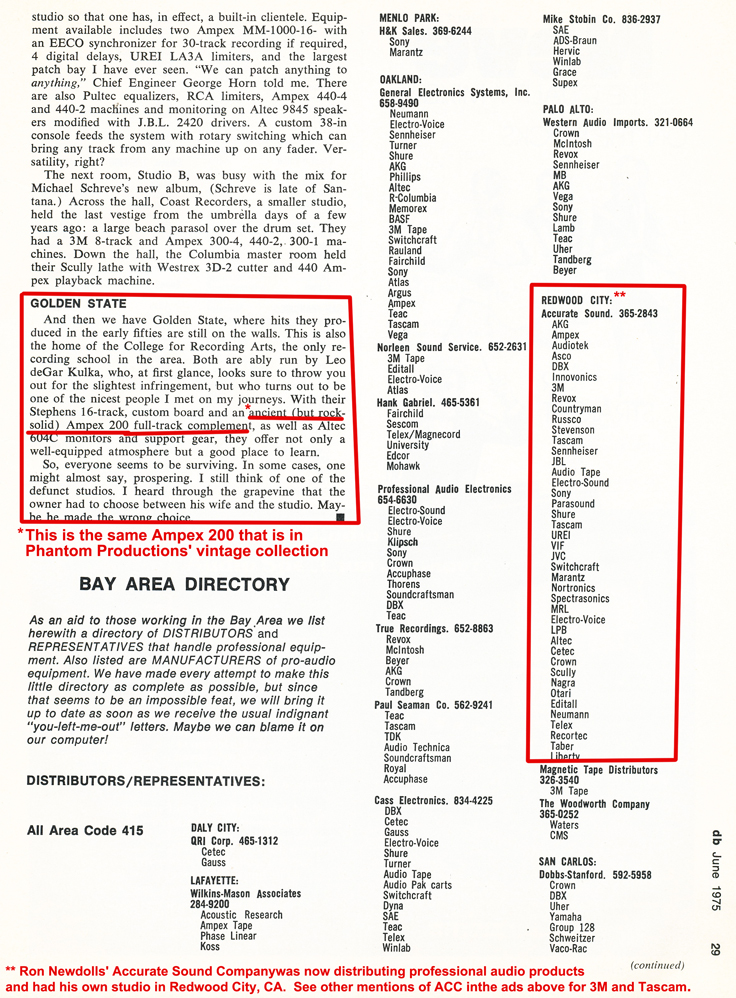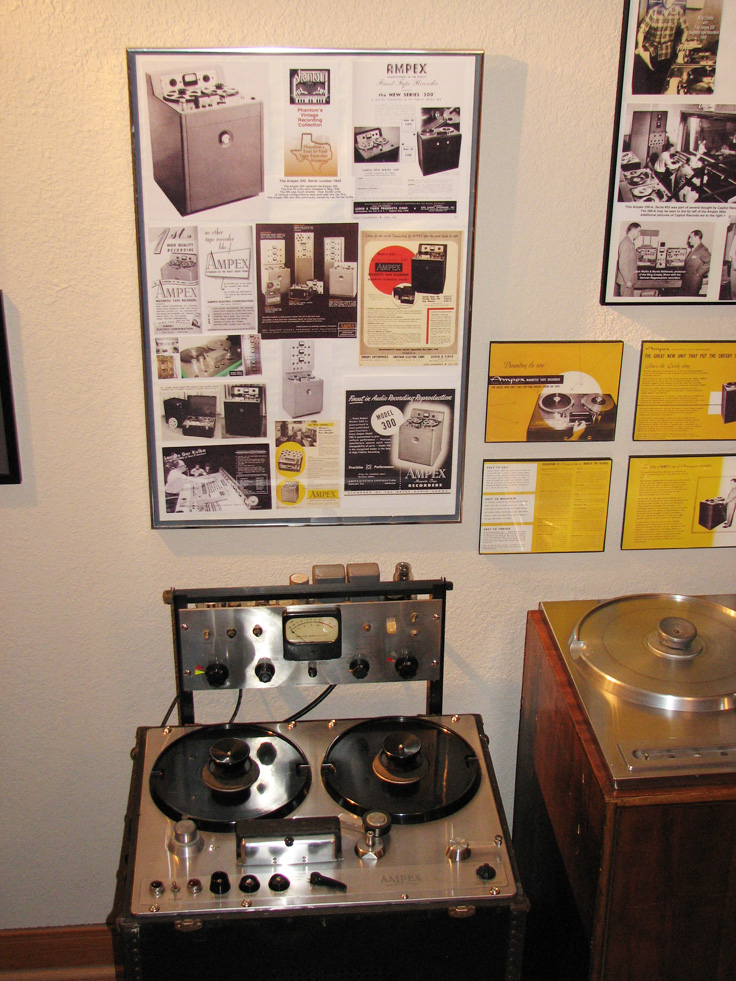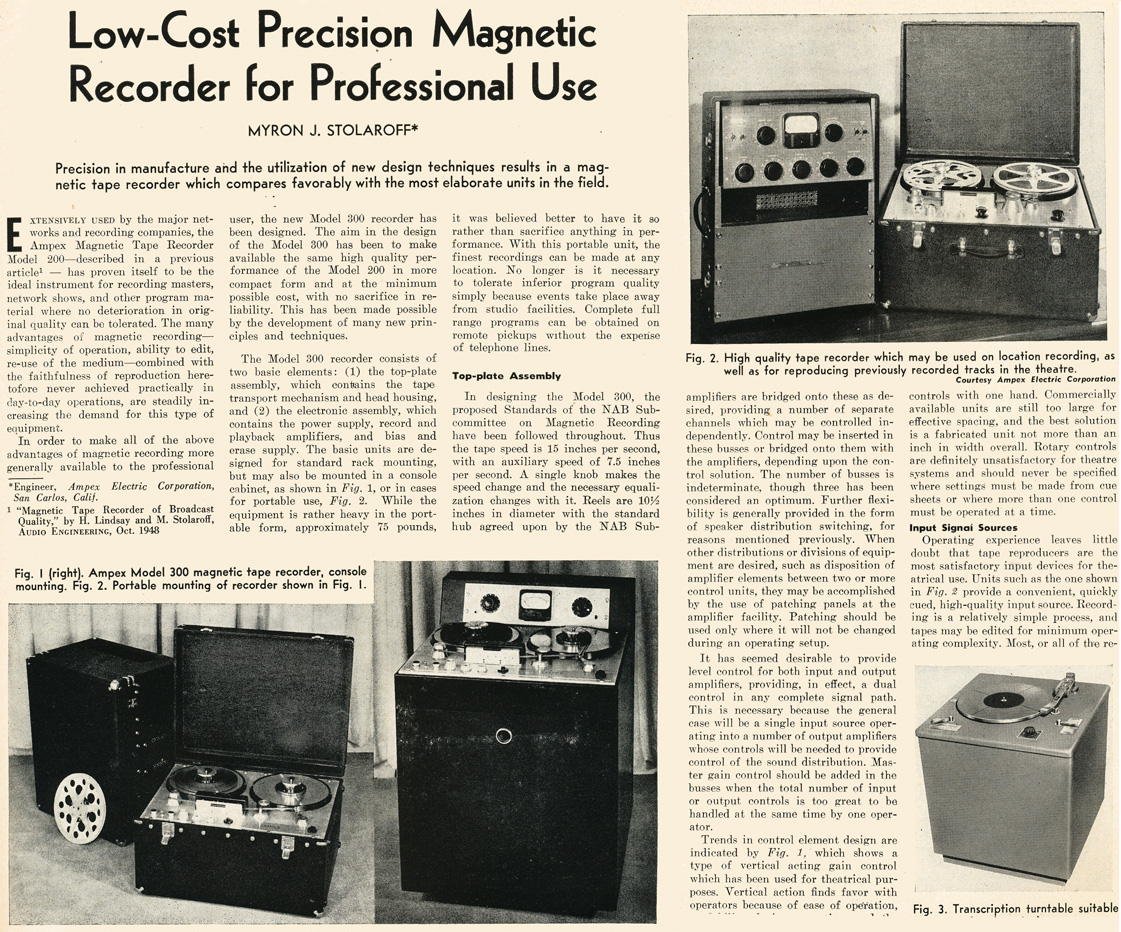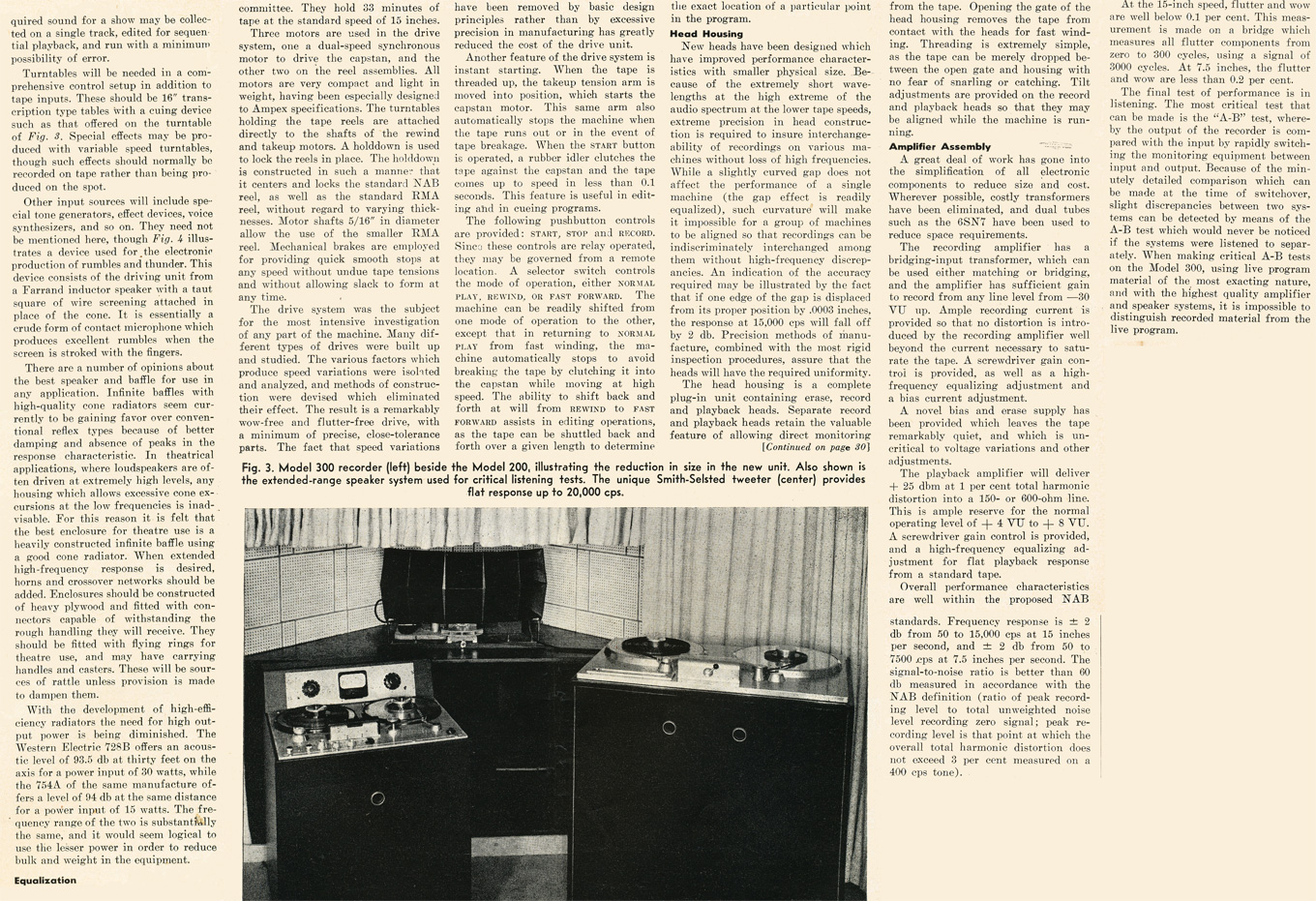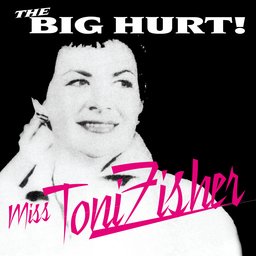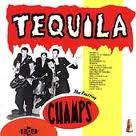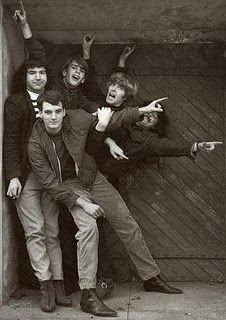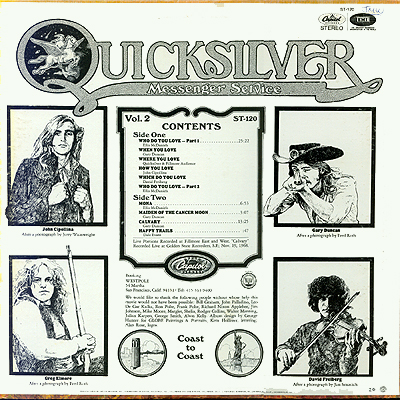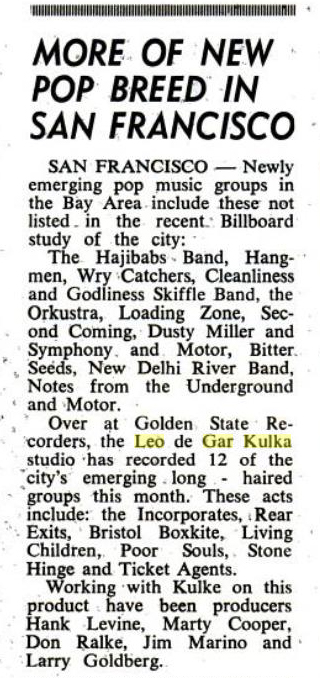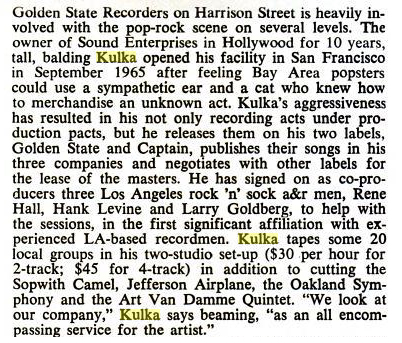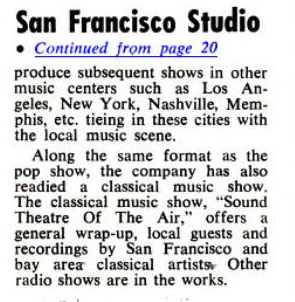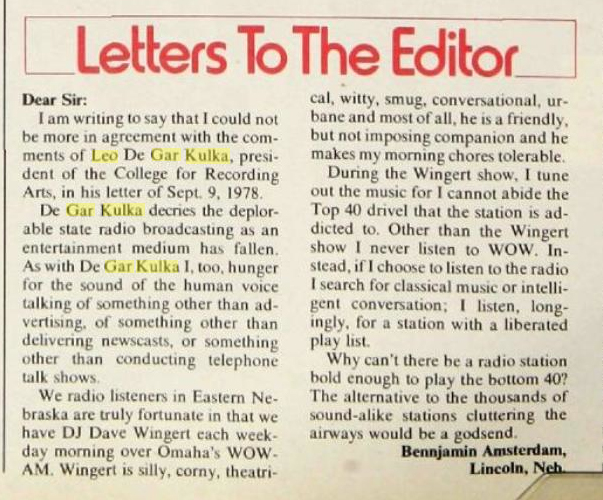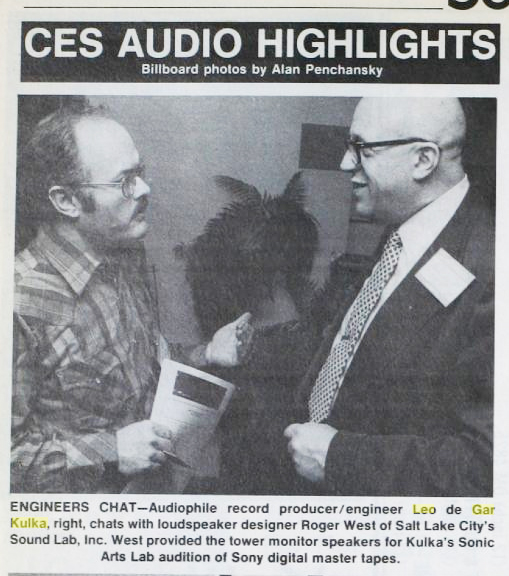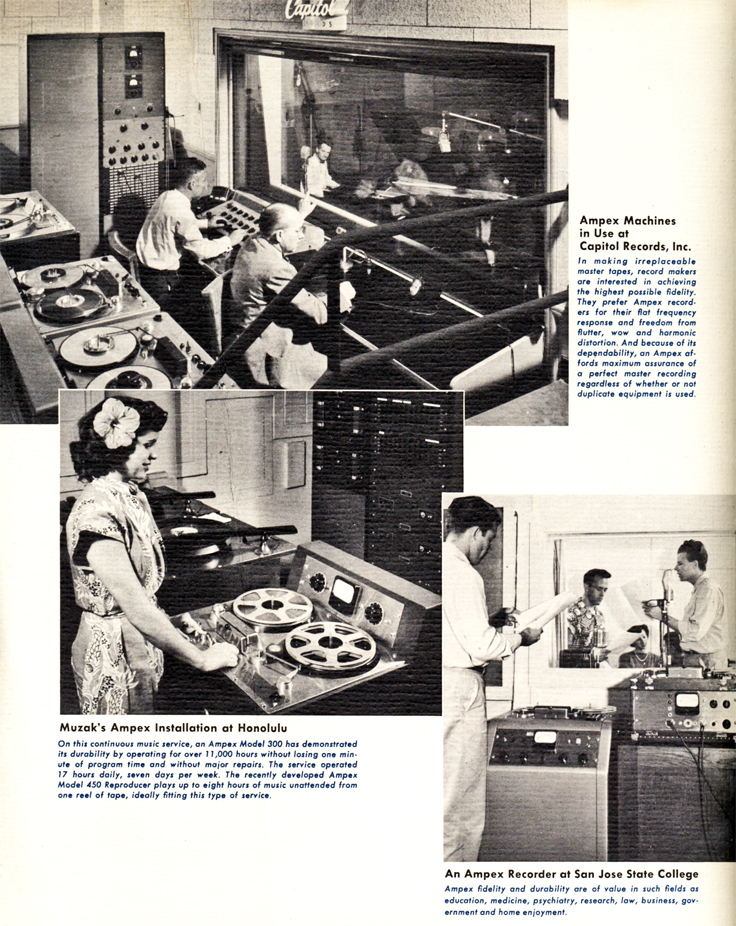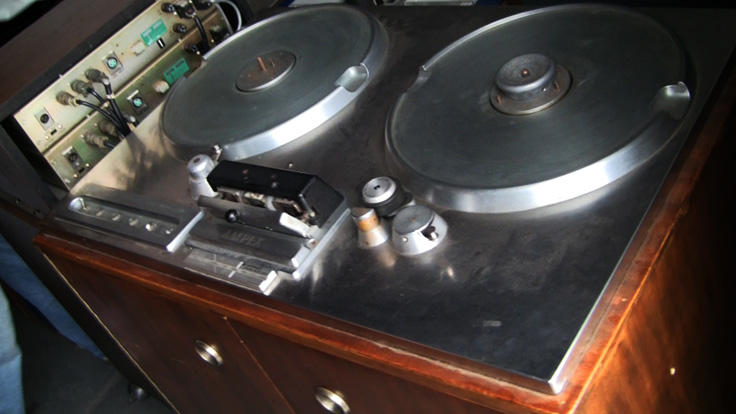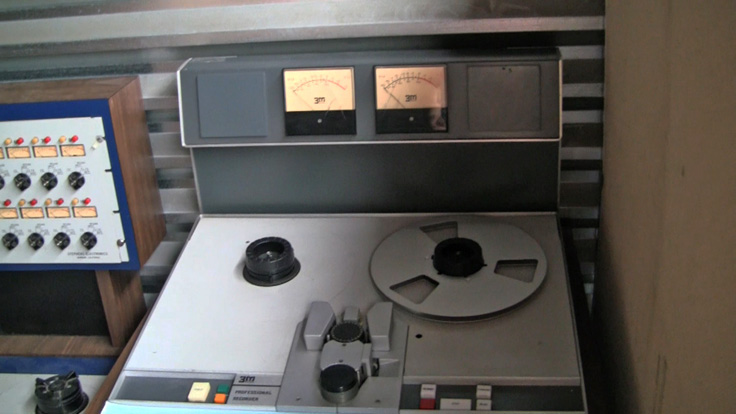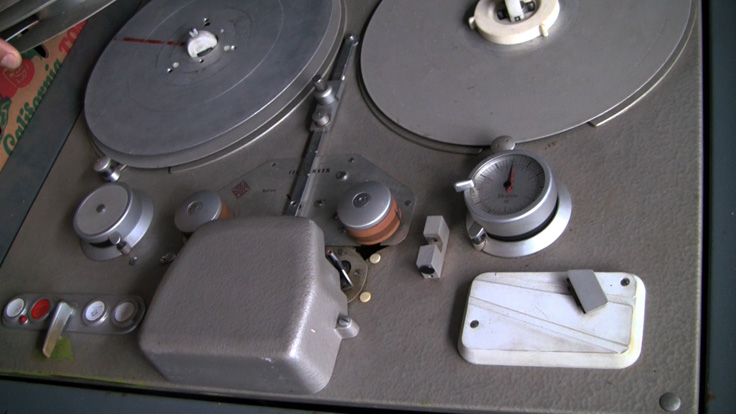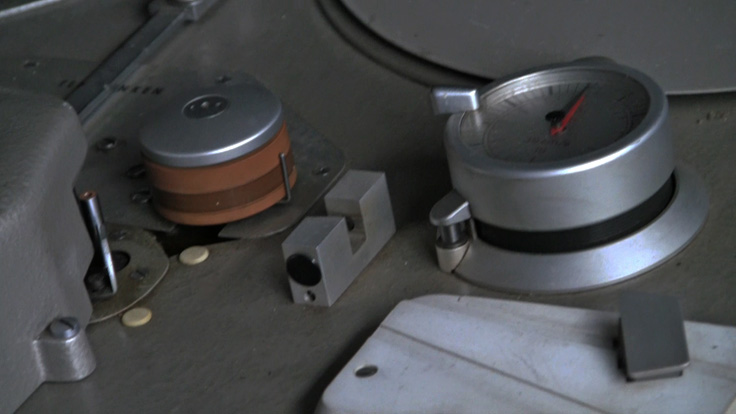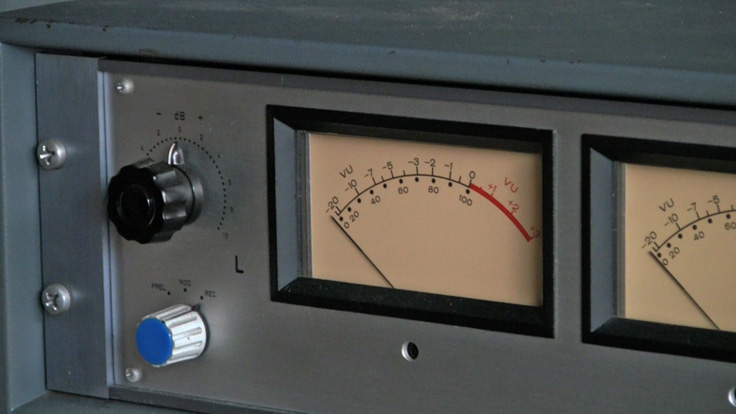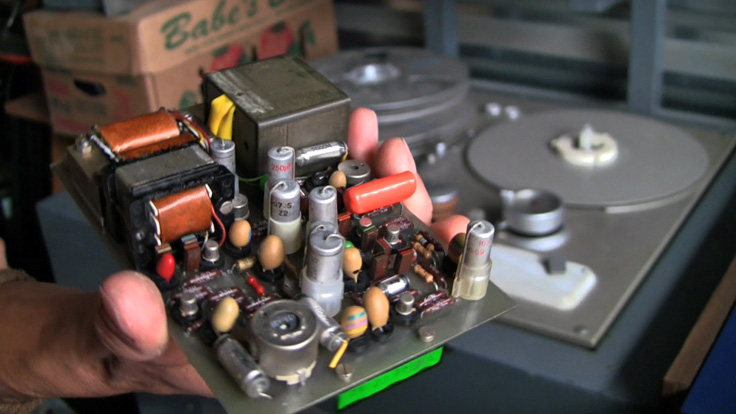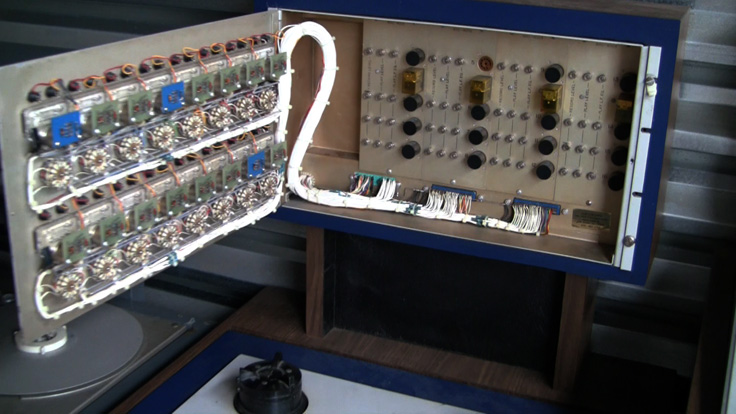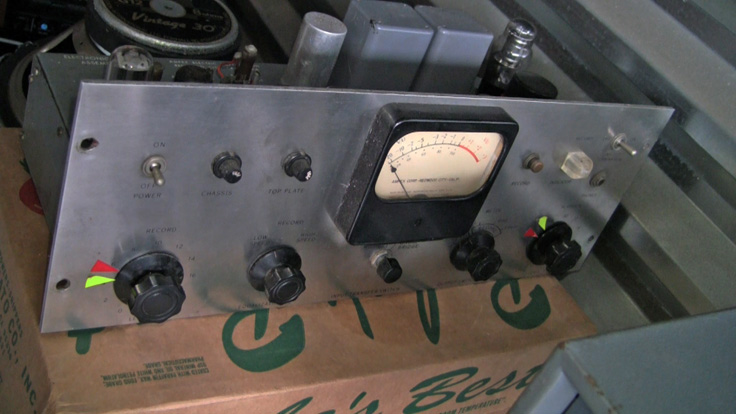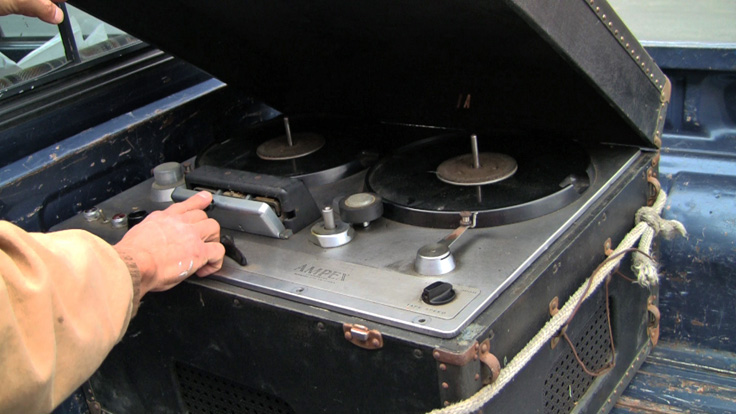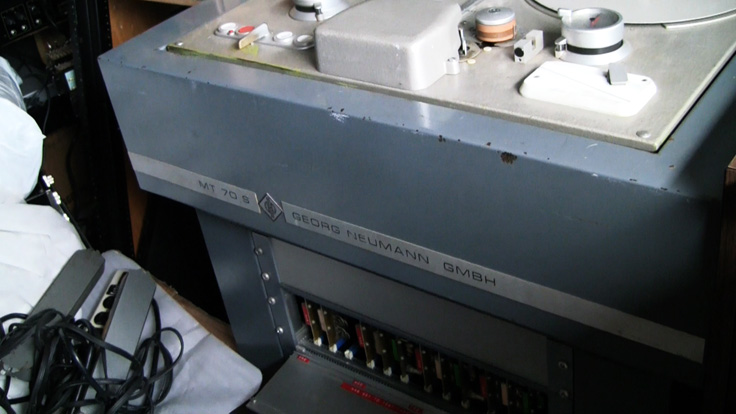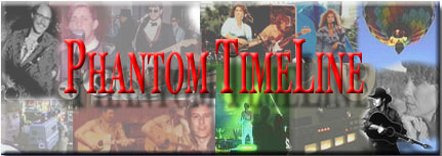|
Reel2ReelTexas Analog Reel To Reel Tape Recorder OnLine Museum Phantom Productions, Inc. • "creative entertainment and production since 1964"
Unfortunately the DVD set is no longer available • Click Here for more info page Share
|
|
This page provides information regarding Phantom Productions, Inc.'s Ampex 200-A and 300 reel tape recorders acquired in 2010
Ampex 200-A Serial #33
Our Ampex 200-A was originally bought from Bing Crosby Enterprises, Inc. by Capitol Records in Los Angeles, California. The news clips below detail some information regarding ABC and Capitol Records decisions to acquire the new technology. Our Ampex 200-A was subsequently acquired by Leo De Gar Kulka, known in the record and recording industry as "the Baron" and remembered for his recording of Frank Sinatra, Nat King Cole, among others. We were told that "the Baron" was always striving to keep up with the latest technology. The Ampex 200-A we acquired was upgraded to stereo using Inovonics amps. We initially were going to restore the recorder to its original state. However after learning more about the history of the unit, we have decided to work to acquire the original electronics, but will leave the unit as is for now. We also have Capitol Records detail regarding the Ampex 200-A, #33's upgrade in 1949. This upgrade to the Ampex 201 specs involved the replacing of the original head cover and installing an Ampex 300 head cover and tape lifters. View the Capitol Records documents here. They also updated this Ampex 200-A in 1954 and 1955. The Ampex 300 (number 1840 of 5,000 which were manufactured) was also previously owned by Leo De Gar Kulka. The amplifier attached to the 300 are the 402/403 electronics. Both units were very well cared for. I have cleaned the units up, however have not began to get them running as of the end of 2010.
I have researched numerous magazine publications, books, AES interviews and held discussions and correspondence with folks who worked on the equipment during the period to provide the following information. There are some source differences and I have tried to represent the essence of the process as the original Ampex equipment evolved. I will update the information as I obtain new details.
Ampex brochure for the Ampex 200-A
The Ampex 200-A cost Ampex approximately $76,000 to develop. It was over engineered, however that resulted in their receiving a reputation of a very high quality product. There are numerous anecdotes described in various resources including the recording capability not being ready when the unit was first demoed for the Crosby folks. There are numerous references to the size and weight of the original 200-A (to which we can heartily attest).
John T."Jack" Mullin seen above in 1949 with the Ampex 200-A and the new Ampex 300 in portable cases• head blocks showing original tape backing facing in. This was later changed to the backing facing out as it remained throughout the remainder of reel to reel production.
As many folks know, John T. "Jack" Mullin (1913 San Francisco - 1999) who was in the US Army Signal Corp., after WW II brought back to the US, 2 German Magnetaphon reel to reel magnetic tape recorders. Mullin took the 2 Magnetophons apart and shipped them back to the US in 18 boxes (to comply with US war souvenir requirements). Also included were 50 rolls of tape. In late 1945 as Mullin was returning from France, he stopped in New Jersey and joined his friend Richard Ranger for Thanksgiving. Mullin shared his information about the Magnetophons and Ranger made a trip to Europe to obtain more first hand information and decided to pursue building a US tape recorder based on the magnetophon information.
Mullin continued on to his home in San Francisco and was happy to find the 18 boxes had arrived safely. He decided to go to work with William A. Palmer studios(founded W.A. Palmer & Co. in San Francisco in 1936) and after tweaking the electronics (converting to US tubes and placing pre-emphasis on the high frequency record circuit and de-emphasis on the playback) the Magnetophons (right) were used to support Palmer's film business. To their knowledge, this was the first time magnetic tape was used to record motion picture sound and the subsequent transfer to film. A memorable Palmer-Mullin demonstration of their magnetic recorders at the MGM studios in Hollywood in October, 1946, grabbed the town's attention with a stunningly clear recording of a studio performance by Jose Iturbi, George E. Stoll and the MGM Symphony Orchestra.
The first public demonstration of the recorders was in San Francisco on May 16, 1946 to the local chapter of the Institute of radio Engineers. Attending the demonstration were Harold Lindsey and Myron Stolaroff who were working for a new company named Ampex (headed by A. M. Poniatoff - company name derived from his initials + EXcellence). They had manufactured radar motors for the military in WW II and were looking for new products to develop. After the demonstration, Lindsey and Stolaroff felt magnetic tape recorders would be Ampex's product.
Subsequently for Mullin and Palmer there were many meetings and demonstrations with the result of attracting Bing Crosby's production folks. Mullin eventually went to work for Crosby as his Chief Engineer, using the 2 Magnetophons and the 50 reels of German tape. He edited the Crosby shows splicing the various tape pieces together as Crosby and his producers directed. Mullin introduced Richard Ranger to the Crosby folks and unfortunately a demonstration of the new Rangertone magnetic recorder did not go well. Mullin then arranged demonstrations by the Ampex company and even though the first demonstration was unable to provide recording, the playback quality was sufficient for the Crosby folks to agree to go with Ampex.
There are two versions of what happened next. Either Bing Crosby invested $50,000 into the startup of Ampex recorder manufacturing, or another version says the Crosby interest enabled banks to back the startup. Around this same time 3M was working on developing magnetic recording tape. When there products were tested, Mullin and the ABC folks decided the high end3M tape was not as good as their low end product. interestingly the iron oxide for the low quality tape was called 112 Raven Red which was also used for red barn paint. ABC bought 24 Ampex 200-As.
The Ampex 200-A was a wonderful sounding machine. Decca (thanks to Bing Crosby) had one of the first ones as did Capitol Records, Melrose. By May of 1949 most major recording studios had one. By June, 1950, NBC, CBS, Mutual, Dumont, etc. had at least one. ABC Radio of course had the first one for Bing back in 1948 and bought 6 others with Bing advancing the money.. Les Paul used his Ampex 200 (modified) to make his amazing records with Mary Ford.. Originals were "B" wind with tape going up and around, inside out.
What does the machine sound like? "(We're Gonna) ROCK AROUND THE CLOCK" was recorded on an Ampex 200-A as were Nat King Cole's "MONA LISA", "UNFORGETTABLE", Mario Lanza's "BE MY LOVE", Frank Sinatra's "YOUNG AT HEART", Tennessee Ernie Ford's "SIXTEEN TONS", etc. Awesome sound at 30 IPS (source unknown)
Ampex is said to have spent $76,000 to develop the first Ampex 200-A's.
There were 112 Ampex 200A's manufactured. Here are some pages from the Ampex upgrade of the 200-A to the 201 configuration in1949.
Some summaries say the first Ampex 200-A's went to Bing Crosby who gave one of them to Les Paul (Bing and Les Paul in picture on left.. However, John Mullin in his interview for Billboard in 1977 says the first 200-A's went to him. Both may be true as Mullin was recording the Crosby shows as Crosby's Chief Engineer and edited the tapes to be played on ABC radio.
There were 5,000 Ampex 300s manufactured. Phantom Productions, Inc's Ampex 300 is serial number 1840 with402/403 electronics and belonged to Leo De Gar Kulka of Golden State recorders, Inc. in the San Francisco Bay area. (another source states there were 42,000 Ampex 300s built)
More detail may be viewed in the Billboard Spotlight interview with John Mullin, November 18, 1977.
Phantom Productions, Inc.'s Ampex 200 reel tape recorder number 33 was originally purchased by Capitol Records. It was subsequently acquired by Leo De Gar Kulka "The Baron." After Mr. Kulka passed away in 1998 the Ampex 200 was acquired from the estate by Nicholas Douhovnikoff. Leo De Gar Kulka first began recording bands while working for Autumn Records in LA. In the 1950's and1960's he worked at LA studios (first at Radio Recorder) then he secured his own facility International Recorders, where he cuts tracks for artists including; Frank Sinatra, Nat "King" Cole, Little Richard, Herb Albert, Sam Cooke plus many more. Eventually he established Golden State Records. More
The Big Hurt
Leo de Gar Kulka engineered for Wayne Shanalin's Big Hurt. They tried to play two machines on playback they flanged and the could not get it in synch.
Thirty years later White Light Productions (Chris Njirich & Bob Giudice) the Big Hurt, hiring Barry Beam and Riche Ray to co-produce, and a vocalist named Marianna and the "big hurt begins." Because of it's reputation we mastered at Sonic Arts only to find out that Leo who mastered the first Big? Hurt now owned Sonic Arts and mastered our Big Hurt.
SFLightBear
Tequila
This was originally released as the B-side of "Train to Nowhere." Disc jockeys flipped the single and played this instead.
Not performing on this record, but later members of the group were Glen Campbell, Jimmy Seals and Dash Crofts (Seals & Crofts of 70s fame). Rio wrote the song. (thanks, WC - Charlotte, NC, for above 2) According to Leo Kulka, who was the second engineer, this song was an afterthought after the band recorded "Train to Nowhere" (the A-side of the record). Some of the musicians had already left the studio when it was brought up that nothing had been recorded for the B-side. The remaining musicians were rounded up and the song was written on the spot. The "Tequila" part of the song was simply a silly attempt to cover up the holes in the song. After all, it was just the B-side. (thanks, Keith - Reno, NV)This was featured in the 1985 movie Pee Wee's Big Adventure. It was used in a scene where Pee Wee Herman wins over the crowd in a biker bar by doing a dance to the song. The movie was the first feature film directed by Tim Burton, and Danny Elfman wrote the score.
This won for Best Rhythm & Blues Performance at the first ever Grammy Awards in 1959. (thanks, Bertrand - Paris, France)
Grateful Dead
The Autumn Sessions was recorded at Golden State Recorders in San Francisco in November 1965. The band used the space under the assumed name of The Emergency Crew (originally the Warlocks, however, one of the band members saw another band using the name).
Disc 1 - Autumn Records sessions (tracks 1 to 6);
Producer - Tom Donahue, Bobby Mitchell
Engineer - Leo De Gar Kulka
Recorded on November 3, 1965 at Golden Gate Recorders, San FranciscoThe Emergency Crew - The Emergency Crew (Autumn ) The pre-Warlocks Grateful Dead recorded this on November 3, 1965 as a demo record at Golden State studios in San Francisco for DJs Tom Donahue's and Bobby Mitchell's Autumn label. Mother's was a club run by the two DJ's. The recordings was made on a two track tape, at 7 1/2 ips. It includes: "Can't Come Down" (Jerry Garcia on vocals); "The Mindbender" (also known as "Confusion's Prince") (Phil Lesh on vocals); "The Only Time Is Now" (Phil Lesh on vocals); "Caution (Do Not Stop On Tracks)" (Pigpen on harmonica and vocals); "I Know You Rider" (Jerry Garcia on vocals); and Gordon Lightfoot's "Early Morning Rain" (Phil Lesh on vocals). Garcia wrote most of the lyrics for "Can't Come Down". Lesh wrote most of the lyrics for "The Mindbender". Golden State Recorders was located at 665 Harrison Street, San Francisco, CA 94107, 415-781-6306. The club Mother's is presently The Stone, which is across from The Mabuhay Gardens.
Quicksilver Messenger
Located on San Francisco's Harrison Street, Golden State Recorders attracted a number of Northern California hippies looking to lay down some tracks.
Owned by Leo De Gar Kulka and home to the Golden State label (which had artists like Wally Cox and The Real Thing and the TCBs), Golden State Recorders was most well-known for being the recording hangout of Dino Valenti's Quicksilver Messenger Service, who recorded their Happy Trails album there in 1969.
Billboard - October 26, 1968
"Golden State Records also has 8-track equipment and a four-man engineering staff. Business is double over last year, says owner Leo Gar Kulka. Upstairs Kulka has installed a rehearsal room(with a 2-track machine) renting for $7.50 an hour. Because his business is almost all pop groups, Kulka helps them study their performance by giving them a tape of their studio session "to analyze exactly what they've done."
Kulka's side business of managing and recording local groups has resulted in his placing 32 acts with a number of labels. E.H. Morris recently took over world-wide administration of Kulka's publishing companies."
At International Sound, Leo De Gar Kulka recorded artists such as Frank Sinatra, Nat "King" Cole, Little Richard, Herb Alpert, Sam Cooke, and Sonny Bono.
Leo De Gar Kulka is credited with working with numerous well known artists including: Sly Stone, Grace Slick, Janis Joplin, Michael Bloomfield, Big Brother, The Sons of Champlin, It's A Beautiful Day, and Quicksilver Messenger Service.
He also founded of the San Francisco Chapter of the NARAS. He chaired the San Francisco AES for several terms, and organized the 93rd AES Convention in San Francisco.
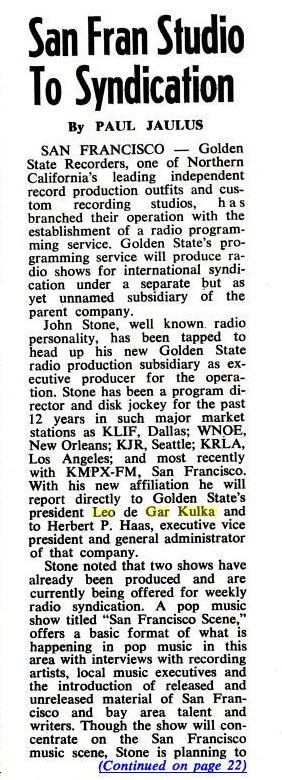
Billboard - October 30, 1971
Billboard - Sept. 23, 1978
Billboard - January 30, 1982
When the Ampex 300 reel tape recorder was acquired by Atlantic Records in 1949, Ahmet Erdogan told the engineer Tommy Dowd that he wanted to keep the disc cutter active for backups - a request he quickly abandoned after hearing the results of the new medium. "Studio Stories - How the Great New York Records Were Made"
The Ampex 400 followed the 300, was sold for $1,000. The unit had only 2 motors was was said to have been a disaster. The 400 was discontinued in 1950. The Ampex 350 and subsequently the 351 were produced. The Ampex 600 was said to be comparable to the Ampex 350 in a portable configuration. 80,000 of the original Ampex 600 were manufactured. In the 1950's Ampex produced the 1/2' instrumentation reel tape recorder. The A500 was a 4 track, 1/2", 30 ips recorder sold by Ampex in 1953.
We provide information on all our Ampex recorders at this link.
These are some pictures from the California trip that show some additional recorders that were previously owned by Leo De Gar Kulka. Also click here for a brief movie of some of the recorders. View
This page provides information regarding Phantom Productions, Inc.'s Ampex 200-A and 300 reel tape recorders acquired in 2010.
PPI Museum Page 1 • Page 2 • Page 3 • Page 4
Vintage Catalogs and Ads • A-D E-K L-O P-R S T U-Z • For Sale • Prices • Unusual & Unique • By Year • View Phantom TimeLine
"Phantom Productions" is the registered trademark of Phantom Productions, Inc. Copyright 2008
All pictures and content on this web site are the property of Theophilus/Reel2ReelTexas
